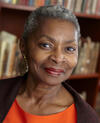In The News: Oral History Research Center
Prominent Black leaders like Woodrow Wilson (not the U.S. president) had to fight tooth and nail to have access to the legislative process. Wilson was Nevada’s first Black legislator who moved to Las Vegas in 1966, at the height of segregation, according to an oral history from the University of Nevada, Las Vegas.

As Las Vegas continues to grapple with food insecurity, one area non-profit is hoping to tackle the issues and provide residents in food deserts with fresh produce.

Oral History Research Center Director Claytee White shares stories people have told her over the years about Las Vegas and explains the importance of recording these memories for historical record.

Charles Kellar was a middle-aged New York attorney with a family, an established law practice and a portfolio of investment properties. But when Thurgood Marshall, then the head of the NAACP’s legal division, asked him to go to Nevada, he went, according to Claytee White, director of the Oral History Research Center at UNLV.

When Nevada Assemblyman Woodrow Wilson went into a Carson City bar where fellow legislators “did their politicking” in the 1960s, they told the owner they wouldn’t continue patronizing the bar if Wilson, who was Black, was there. The bar owner told Wilson about the incident, and he learned the legislators were the same ones who had tried to buy him drinks and make him feel welcome.

UNLV'S Oral History Research Center is embarking on a project tracking the history of sports in Las Vegas. "It's kind of hard not to think about sports when you think about Las Vegas right now," said Oral History Research Center Project Manager Stefani Evans.
The building that housed the Holy Cow Casino and Brewery, on the northeast corner of Sahara and the Strip, made Las Vegas history for a couple of big reasons.

As Sara told UNLV oral historian Claytee White, “From the day Roosevelt was elected we had a picture of him in our house. And I still have it in my house.”
In 1960, Dr. James B. McMillan served as president of the local Las Vegas NAACP, Branch 1111. In March of that year, he received a letter from the organization’s national office in New York — encouraging branches nationwide to elevate activities that would lead to integration of public accommodations. McMillan, using that same mode of communication, sent a letter to Las Vegas Mayor Oran Gragson — demanding integration of the Strip and Downtown in two weeks. McMillan clearly stated that if integration did not occur, the Black community would march down the Strip on the Saturday evening of March 26, 1960.

About half a block away from where a now-viral TikTok was filmed showing racist harassment against a Black man sits a state historical marker titled “African Americans and the Boston Saloon.” It details the story of William A.G. Brown — a freeborn Black man who, between 1866 and 1875, operated the Boston Saloon, one of the mining boomtown’s best known taverns. Decorated with intricate gas lamps and crystal goblets, the saloon offered an upscale atmosphere that contrasted the stereotypical image of a seedy saloon — even recognized by figures such as Mark Twain.

About half a block away from where a now-viral TikTok was filmed showing racist harassment against a Black man sits a state historical marker titled “African Americans and the Boston Saloon.” It details the story of William A.G. Brown — a freeborn Black man who, between 1866 and 1875, operated the Boston Saloon, one of the mining boomtown’s best known taverns. Decorated with intricate gas lamps and crystal goblets, the saloon offered an upscale atmosphere that contrasted the stereotypical image of a seedy saloon — even recognized by figures such as Mark Twain.
In 2002, hip-hop singer Mary J. Blige sang “Blue Suede Shoes,” a Carl Perkins song popularized by Elvis Presley, during the “Divas Live” special on cable network VH1. She later told the Atlanta Journal-Constitution: “I prayed about it because I know Elvis was a racist. But that was just a song VH1 asked me to sing. It meant nothing to me. I didn’t wear an Elvis flag. I didn’t represent Elvis that day.”

